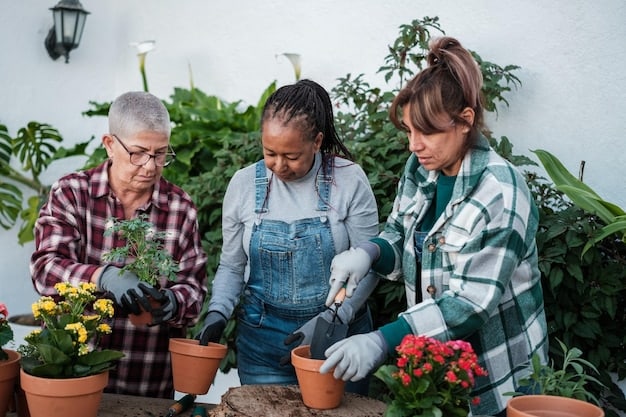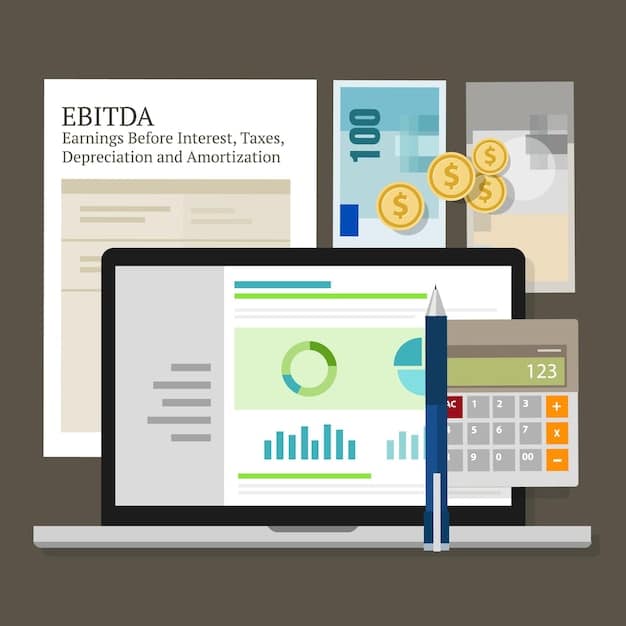Secure $10,000 for Community Action Projects in 2025

Community action projects can secure $10,000 grants in 2025 by meticulously researching suitable funding opportunities, crafting compelling proposals, demonstrating clear community impact, and strategically networking with potential funders and partners to highlight project viability and sustainability.
Navigating the complex landscape of grant funding can often feel like a daunting task for community action projects. Securing even a modest sum, such as a $10,000 grant, can be transformative, enabling crucial initiatives to take root and flourish. This guide provides actionable insights and strategic approaches for community leaders aiming to unlock these vital resources in 2025.
Understanding the Funding Landscape for Community Action Projects in 2025
The funding environment for community action projects is dynamic, influenced by economic shifts, societal priorities, and philanthropic trends. In 2025, organizations need to understand that funders are increasingly looking for projects that demonstrate not just immediate impact but also long-term sustainability and measurable outcomes. This shift requires a more strategic approach to grant seeking, moving beyond traditional applications to showcase a comprehensive understanding of community needs and how the project directly addresses them.
Funders are often driven by specific missions and values, seeking alignment with projects that amplify their own objectives. It’s not just about what you need, but how your project helps them achieve their goals. This means thorough research into potential funders is paramount, ensuring that your project’s objectives resonate with their funding priorities. The competition for grants is fierce, so standing out requires a clear, concise, and compelling narrative that truly articulates the project’s unique value proposition.
Identifying Potential Funders and Opportunities
The first step in securing a $10,000 grant is to identify the right funding sources. This involves more than just a quick search; it demands a deep dive into databases, foundation websites, and local government programs. Look for organizations that have a history of supporting projects similar to yours in scope, scale, or geographic focus.
- Local Foundations: Often have specific mandates to support community initiatives within their region.
- Corporate Giving Programs: Many corporations dedicate funds to social responsibility efforts, aligning with community development.
- Government Agencies: Federal, state, and local governments frequently offer grants for specific community improvement projects, such as environmental, educational, or health-related initiatives.
- Community Funds & Endowments: These are often established to address local needs and can be excellent sources for smaller grants.
Beyond these traditional sources, consider emerging trends in philanthropy, such as impact investing or crowdfunding platforms specifically designed for community projects. While not direct grants, they can complement a funding strategy, especially for projects with strong public appeal. Networking within the non-profit sector can also uncover hidden opportunities and provide insights into successful funding approaches.
The key is to diversify your search and not put all your eggs in one basket. A multi-pronged approach increases your chances of finding a grant that is a perfect fit for your project’s mission and needs for 2025.
As you research, pay close attention to eligibility criteria, funding cycles, and application deadlines. Missing a key detail can result in an automatic disqualification, no matter how strong your project is. Keeping an organized tracking system for potential funders, their requirements, and your progress with each application is crucial for managing this complex process effectively.
Crafting a Compelling Grant Proposal: The Foundation of Success
A well-prepared grant proposal is the cornerstone of a successful funding application. It’s your opportunity to tell your project’s story, articulate its impact, and convince funders that their investment will yield meaningful returns for the community. A compelling proposal goes beyond simply listing needs; it presents a clear vision, a detailed plan, and a persuasive argument for why your project deserves support.
Funders are inundated with applications, so your proposal must stand out by being clear, concise, and persuasive. Avoid jargon and overly technical language, ensuring your narrative is accessible to a broad audience, including those who may not be experts in your specific field. Every section should flow logically, building a strong case piece by piece.
Key Components of a Strong Proposal
While specific requirements vary, most grant proposals share common elements that need meticulous attention. Each component should collectively paint a picture of a well-conceived, impactful, and sustainable project.
- Executive Summary: A concise overview of your project, its goals, and why it deserves funding. It should grab the funder’s attention immediately.
- Problem Statement/Needs Assessment: Clearly define the community problem your project addresses, supported by data and evidence.
- Project Description: Detail what your project will do, how it will be implemented, and who it will serve. Outline specific activities and timelines.
- Goals and Objectives: State measurable outcomes that demonstrate the project’s success. How will you know if your project has made a difference?
- Evaluation Plan: Describe how you will track progress, collect data, and assess the project’s impact. Funders want to see accountability.
- Budget: A detailed breakdown of how the $10,000 grant will be used, along with any other funding sources or in-kind contributions. Justify every expense.
- Organizational Capacity: Demonstrate that your team has the experience, expertise, and resources to successfully execute the project.
Remember, the proposal is not just about what you want to do, but why it matters and how you will achieve it. Each section should reinforce your project’s value and your organization’s capability. Paying close attention to the funder’s specific guidelines and tailoring your proposal to their interests will significantly increase your chances of success.

Demonstrating Measurable Impact and Sustainability
Funders are increasingly focused on impact. It’s not enough to simply state good intentions; you must demonstrate how your project will create tangible, positive change within the community. For a $10,000 grant, this means clearly articulating what specific outcomes will be achieved with these funds and how those outcomes will be measured. Sustainability is another critical factor, reassuring funders that their investment will have lasting benefits beyond the initial grant period, fostering long-term community resilience.
To truly stand out, projects should include robust evaluation plans. This involves detailing the metrics you’ll use, the data collection methods, and how you will report on your progress. Funders want to see that their money is being used effectively and that your project is committed to accountability and continuous improvement. Without a clear plan for evidencing impact, even the most well-intentioned project can struggle to secure funding.
Articulating Outcomes and Metrics
When seeking a $10,000 grant, precision in defining outcomes is essential. Instead of vague statements like “we will help the community,” focus on specific, quantifiable goals. For example, “we will provide healthy meals to 50 low-income families over three months,” or “we will train 20 community volunteers in first-aid by year-end.”
- Input: Resources invested (e.g., $10,000 grant, volunteer hours).
- Output: Direct products or services (e.g., number of workshops, number of meals provided).
- Outcome: Changes in participants’ knowledge, attitudes, behaviors, or conditions (e.g., increased civic engagement, improved health outcomes).
- Impact: Long-term, broader changes in the community (e.g., reduced crime rates, improved educational attainment).
For a smaller grant like $10,000, focusing on clear, achievable short-term outcomes that contribute to a larger long-term goal is often more effective. This allows funders to see immediate returns on their investment while understanding the broader vision.
Moreover, consider the qualitative aspects alongside the quantitative. Personal stories, testimonials, and narratives can powerfully illustrate the human side of your project’s impact, complementing numerical data and bringing your proposal to life. Demonstrating both types of impact paints a more complete and compelling picture for potential funders.
Building Strong Partnerships and Community Support
Community action projects thrive on collaboration. Building strong partnerships and demonstrating broad community support can significantly strengthen your grant application for a $10,000 grant in 2025. Funders are often looking for projects that are deeply embedded within the community, showing that there’s a collective effort and shared responsibility for success. This not only enhances the project’s legitimacy but also increases its chances of long-term sustainability.
Collaboration can take many forms, from formal partnerships with other non-profits or local businesses to informal alliances with community leaders and resident groups. Each partnership adds value, whether through shared resources, expanded reach, or diverse perspectives. These alliances demonstrate that your project isn’t operating in isolation but is part of a larger ecosystem committed to community well-being.
Leveraging Collaboration and Endorsements
Partnerships can provide invaluable resources, expertise, and credibility. When applying for grants, highlighting these collaborations shows funders that your project has a strong support network and diversified capacity. Think about how different community actors can contribute to your project’s success.
- Non-profit Organizations: Partner for shared resources, complementary expertise, or to serve a broader audience.
- Local Businesses: May offer in-kind donations, volunteer hours, or financial support, demonstrating corporate social responsibility.
- Government Agencies: Collaboration can lead to policy alignment, access to public resources, and enhanced credibility.
- Community Leaders & Residents: Their endorsement shows grassroots support and ensures the project genuinely addresses community needs.
Including letters of support or memoranda of understanding (MOUs) from key partners in your grant application can significantly bolster your case. These documents serve as tangible proof of commitment and collaboration, signaling to funders that your project is well-regarded and supported within the community. Explicitly articulating the roles and contributions of each partner further strengthens the application.
In addition to formal partnerships, showcasing anecdotal evidence of community engagement – such as participation in planning meetings, surveys, or volunteerism – can be very powerful. This demonstrates that the community itself is invested in the project’s success, which is a major draw for funders looking for sustainable, community-driven initiatives.
Effective Budgeting and Financial Transparency for a $10,000 Grant
Securing a $10,000 grant requires not just a compelling vision but also a clear and transparent financial plan. Funders need assurance that their money will be managed responsibly and used effectively to achieve the stated project goals. An effective budget is more than just a list of expenses; it’s a strategic document that illustrates how every dollar contributes to the project’s success and how the overall financial health of the organization supports this endeavor.
Financial transparency extends beyond the budget itself. It encompasses a clear understanding of your organization’s broader financial position, including other funding sources, in-kind contributions, and strategies for managing funds. This demonstrates fiscal responsibility and builds trust with potential funders, who are looking to invest in organizations with sound financial management practices.
Creating a Detailed and Justified Budget
For a $10,000 grant, your budget should be impeccably detailed and every line item justified. Funders want to see how the money directly supports the project’s activities and outcomes. Avoid vague categories; instead, itemize expenses as much as possible.
- Personnel Costs: Clearly define roles, salaries, and time allocated to the project. Even if staff are volunteers, it can be useful to show the in-kind value.
- Program Expenses: Break down costs for materials, supplies, event logistics, and direct services.
- Administrative Overhead: Include a reasonable percentage for administrative costs, explaining why these are essential for project success (e.g., rent, utilities, insurance).
- Travel: If applicable, detail travel-related expenses, including mileage, accommodations, and per diems.
- Equipment/Technology: List any specific equipment needed, along with its justification for the project.
It’s crucial to align your budget with your project activities and objectives. Each expense should directly relate to a specific goal outlined in your proposal. If a funder only sees a total number, it’s hard for them to understand the value for money. A detailed budget provides clarity and confidence. Also, consider including a budget narrative that explains each line item and how it contributes to the overall project, especially if certain expenses might seem less obvious.

Furthermore, indicate any other funding sources, whether secured, pending, or in-kind contributions, to show that the $10,000 grant is part of a larger, well-rounded financial strategy. This demonstrates that your project is not solely reliant on one funding source and that you have a comprehensive plan for resource mobilization. This holistic view reinforces your project’s viability and strengthens your funding appeal.
Navigating the Grant Application Process and Follow-Up
Beyond crafting a stellar proposal, successfully securing a $10,000 grant in 2025 involves understanding the nuances of the application process itself and the critical importance of effective follow-up. Many organizations overlook these aspects, assuming that a well-written proposal is enough. However, meticulous attention to submission requirements, adherence to deadlines, and strategic communication with funders can significantly tip the scales in your favor. It’s a competitive landscape, and every detail matters in distinguishing your application.
The grant-seeking journey doesn’t end when you hit “submit.” Post-submission engagement, respectful follow-up, and, if successful, diligent reporting are all part of building long-term relationships with funders. These relationships can lead to future funding opportunities and establish your organization as a trustworthy and impactful community partner, an invaluable asset for sustained project growth.
Preparation, Submission, and Post-Application Engagement
The application process can be intricate. Before even beginning to write, carefully review all funder guidelines, paying close attention to formatting, word limits, and required attachments. Missing a single item can lead to an automatic rejection.
- Read Instructions Carefully: Ensure every requirement is met. What might seem minor can be critical.
- Proofread Meticulously: Errors diminish professionalism. Have multiple people review the application.
- Submit Early: Avoid last-minute technical glitches. Submitting ahead of the deadline shows preparedness.
- Confirmation of Receipt: If not automatic, check that your application was received.
- Follow-Up (Respectfully): If appropriate, a brief, polite inquiry after a reasonable period can confirm status, but avoid being pushy.
- Learn from Rejections: If unsuccessful, request feedback. Use it to improve future proposals.
An often-underestimated aspect is the potential to build a relationship with program officers. While not always feasible for smaller grants or general applications, if there’s a named contact, a polite, concise query before submission can clarify guidelines or provide valuable insights. This shows initiative and genuine interest in aligning with their mission. However, this must be handled with discretion and respect for their time, ensuring that the interaction is genuinely useful for both parties. Building a positive, professional relationship can be beneficial, regardless of the immediate funding outcome.
Measuring and Reporting on Grant Outcomes
Securing a $10,000 grant is just the beginning; the true measure of success lies in effectively implementing the project and rigorously reporting on its outcomes. Funders invest in projects that demonstrate tangible results and accountability. A robust system for tracking progress and accurately reporting on how the grant funds were utilized, and what impact was achieved, is crucial for maintaining donor trust and opening doors for future funding opportunities in 2025 and beyond.
Measuring outcomes goes beyond simply tallying activities. It involves assessing the changes that occur as a direct result of your project’s interventions. This requires careful planning from the outset, integrating data collection methods into your project design. Transparent and timely reporting not only fulfills grant obligations but also serves as a powerful tool for showcasing your organization’s effectiveness and commitment to its mission.
Effective Data Collection and Reporting Strategies
To demonstrate the value of a $10,000 grant, your reporting must be clear, concise, and backed by evidence. Establish your data collection methods early in the project’s lifecycle.
- Establish Baseline Data: Know where you’re starting from to accurately measure change.
- Consistent Data Collection: Use surveys, interviews, observation, or existing records to gather information throughout the project.
- Quantitative and Qualitative Data: Combine numbers with stories to paint a comprehensive picture of impact.
- Regular Progress Reports: Keep funders informed even before formal reporting periods, if appropriate.
- Final Grant Report: Address all specified requirements, including a financial summary and narrative of outcomes achieved.
- Share Successes: Use media, social channels, and your website to publicize how the grant made a difference.
When preparing your reports, focus on the goals and objectives outlined in your original proposal. Did you meet them? If not, why? Be transparent about challenges and how you adapted. Funders appreciate honesty and problem-solving. Highlight key achievements, unforeseen positive impacts, and lessons learned. This reflective approach demonstrates that your organization is not only effective but also committed to continuous learning and improvement, which can foster long-term partnerships with funders.
Leveraging Small Grants for Future Growth and Impact
While securing a $10,000 grant might seem modest in the broader philanthropic landscape, its strategic importance for community action projects should not be underestimated. These grants often serve as critical seed funding, allowing nascent ideas to be piloted, small-scale projects to be implemented, and foundational work to be laid. This initial investment can create a powerful ripple effect, demonstrating proof of concept and building a track record of success that is invaluable for attracting larger funding opportunities in the future. In 2025, showing effective utilization of even small grants will be key to unlocking greater resources.
The experience gained from managing a $10,000 grant, from proposal writing to project implementation and reporting, hones an organization’s capacity and credibility. It provides a tangible case study of impact, which can be leveraged in subsequent applications to larger foundations or government programs. This incremental approach to funding can be a sustainable pathway for growth, allowing community projects to expand their reach and deepen their impact over time. Think of it as a strategic stepping stone, not just an end goal.
Building a Track Record and Scaling Impact
Every successful grant, regardless of its size, contributes to your organization’s reputation and portfolio. Using a $10,000 grant effectively is a testament to your capability and commitment.
- Document Everything: Keep meticulous records of project activities, expenditures, and outcomes. This data is crucial for future proposals.
- Showcase Success Stories: Collect testimonials, photos, and videos that highlight the human impact of your project. These narratives are powerful.
- Publicize Your Achievements: Share your successes with your community, local media, and on social media. Acknowledging funders publicly is also good practice.
- Re-engage Funders: Even if a funder only offered a one-time grant, keep them informed of your progress. They might be interested in future stages or larger grants.
- Strategic Planning: Use the experience of a small grant to refine your organizational strategies and identify areas for scaling up.
Successfully managing and reporting on a $10,000 grant provides valuable operational experience for your team, covering everything from financial management to marketing and community engagement. This practical experience is often as valuable as the funds themselves, building internal capacity that prepares the organization for more complex projects and larger funding streams. By treating every grant as an opportunity to learn and grow, community action projects can systematically build their capacity to secure more significant investments and achieve a broader, more sustainable impact for their communities.
| Key Action | Brief Description |
|---|---|
| 🔍 Funder Research | Identify grants aligning with project mission and specific funding priorities. |
| 📝 Proposal Crafting | Develop a clear, concise, and compelling narrative with measurable outcomes. |
| 🤝 Partnership Build | Foster collaborations to strengthen project legitimacy and resource base. |
| 📈 Impact Reporting | Track and report on project results transparently to build trust and credibility. |
Frequently Asked Questions About Securing Grants
The most crucial step is thorough research to identify funders whose mission and priorities perfectly align with your project. A well-aligned application significantly increases your chances, as funders prefer projects that directly address their strategic objectives, making efficient use of their philanthropic efforts and resources in the community.
Community participation is exceptionally important. Funders often prioritize projects that demonstrate strong grassroots support and involvement, as this indicates genuine community need and a higher likelihood of sustainability. Documenting community input and volunteer engagement strengthens your proposal significantly, showcasing collective commitment and shared responsibility for success.
Yes, new projects can secure $10,000 grants, especially if they present a compelling vision, clear objectives, and strong evidence of community need. While established track records help, clear articulation of potential impact and a well-thought-out plan can impress funders looking to support innovative, promising initiatives, particularly those with strong community roots.
To support your budget, include detailed breakdowns of all anticipated expenses, quotes for services or materials, and a clear narrative justifying each line item’s necessity. Additionally, highlight any in-kind contributions or other secured funding to demonstrate efficient resource utilization and a well-rounded financial strategy that maximizes the grant’s impact effectively.
If your application is rejected, always seek feedback from the funder if possible. Use their insights to identify weaknesses in your proposal or project design and refine them for future applications. Rejection is an opportunity for learning and improvement, strengthening your capacity to secure funding in the future and enhancing your project’s overall viability.
Conclusion
Securing a $10,000 grant for community action projects in 2025 is an achievable goal, provided organizations adopt a strategic, meticulous approach. It demands more than just identifying a need; it requires in-depth research into funding alignments, the careful crafting of a compelling, evidence-based proposal, and a steadfast commitment to demonstrating measurable impact and sustainability. Building strong community partnerships and maintaining transparent financial practices further solidifies an application, showcasing a project’s legitimacy and long-term viability. By focusing on these core elements, community leaders can unlock crucial funding, transforming aspirations into tangible, positive change.





